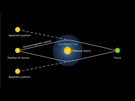Sunshine Forever?
How long will the Sun continue to shine?
A shining and 'well functioning' Sun is critical for our survival on Earth. The Sun was formed almost five billion years ago. At that time, a gas and dust cloud became so condensed due to its own gravity that hydrogen nuclei began to merge with each other and release huge amounts of energy in a process known as nuclear fusion.
 © Tablizer (CC-BY-SA 2.5) |
The diagram shows (not to scale) the development of our Sun, from its formation around 4.6 billion years ago to the white dwarf stage. The final stage as a black dwarf is not shown, as it is still not known how long it takes for a white dwarf to cool down completely.
Fortunately, the Sun's supply of hydrogen is so great that it will continue to shine for another five billion years. However, the intensity of the solar radiation will increase in the future and this will be fatal for life on Earth. As early as two to three billion years from now, the oceans will evaporate and it will become impossible to live on Earth.
On approximately its ten-billionth birthday – that is, in around five billion years from now – the hydrogen supply in the core of the Sun will be exhausted and the generation of energy will shift to the outer layers. As a result of this change, the Sun will expand and become a red-colored giant star that engulfs the planets closest to it – Mercury and Venus. As a 'Red Giant', our Sun will lose a considerable amount of mass – by expanding sharply, the gravitational force at its surface will decrease and, unlike now, a lot of solar matter will pour into space. As its mass reduces, the planets will not be attracted to the Sun as strongly as at present and their orbits around the Sun will shift further outwards. The Earth will gradually move to where the planet Mars orbits today.
From Red Giant to White Dwarf
This does not by any means spell the end of the Sun's dance of death – helium will become concentrated in the center of the giant red Sun and will begin to 'melt' – forming heavier elements by means of nuclear fusion. This will cause the Sun to contract again as it slightly collapses inward. Near the end of the red giant stage, the helium-fusion zone will also shift to the outer layers of the Sun and the Sun will inflate again. At this point, the fusion of helium will cease, leaving the Sun without a source of energy.
Once the outward force caused by radiation pressure is absent, the solar mass will collapse inward. During this collapse, the Sun’s surface will heat up again – so much so that it will emit a significant amount of ultraviolet radiation. This will heat the matter that was previously ejected into space and cause it to glow – a 'planetary nebula' will be formed. At the nebula's center, the Sun will remain as a glowing 'white dwarf' star. The White Dwarf will be about the size of Earth, but its matter will be so densely packed together that a piece the size of a sugar cube will weigh a ton. Over the course of several more billions of years, the White Dwarf will slowly cool down – becoming a 'black dwarf' – and then our Sun will finally have disappeared.
German Aerospace Center
On approximately its ten-billionth birthday – that is, in around five billion years from now – the hydrogen supply in the core of the Sun will be exhausted and the generation of energy will shift to the outer layers. As a result of this change, the Sun will expand and become a red-colored giant star that engulfs the planets closest to it – Mercury and Venus. As a 'Red Giant', our Sun will lose a considerable amount of mass – by expanding sharply, the gravitational force at its surface will decrease and, unlike now, a lot of solar matter will pour into space. As its mass reduces, the planets will not be attracted to the Sun as strongly as at present and their orbits around the Sun will shift further outwards. The Earth will gradually move to where the planet Mars orbits today.
From Red Giant to White Dwarf
This does not by any means spell the end of the Sun's dance of death – helium will become concentrated in the center of the giant red Sun and will begin to 'melt' – forming heavier elements by means of nuclear fusion. This will cause the Sun to contract again as it slightly collapses inward. Near the end of the red giant stage, the helium-fusion zone will also shift to the outer layers of the Sun and the Sun will inflate again. At this point, the fusion of helium will cease, leaving the Sun without a source of energy.
Once the outward force caused by radiation pressure is absent, the solar mass will collapse inward. During this collapse, the Sun’s surface will heat up again – so much so that it will emit a significant amount of ultraviolet radiation. This will heat the matter that was previously ejected into space and cause it to glow – a 'planetary nebula' will be formed. At the nebula's center, the Sun will remain as a glowing 'white dwarf' star. The White Dwarf will be about the size of Earth, but its matter will be so densely packed together that a piece the size of a sugar cube will weigh a ton. Over the course of several more billions of years, the White Dwarf will slowly cool down – becoming a 'black dwarf' – and then our Sun will finally have disappeared.
German Aerospace Center
Sunshine Forever?
How long will the Sun continue to shine?
A shining and 'well functioning' Sun is critical for our survival on Earth. The Sun was formed almost five billion years ago. At that time, a gas and dust cloud became so condensed due to its own gravity that hydrogen nuclei began to merge with each other and release huge amounts of energy in a process known as nuclear fusion.
 © Tablizer (CC-BY-SA 2.5) |
The diagram shows (not to scale) the development of our Sun, from its formation around 4.6 billion years ago to the white dwarf stage. The final stage as a black dwarf is not shown, as it is still not known how long it takes for a white dwarf to cool down completely.
Fortunately, the Sun's supply of hydrogen is so great that it will continue to shine for another five billion years. However, the intensity of the solar radiation will increase in the future and this will be fatal for life on Earth. As early as two to three billion years from now, the oceans will evaporate and it will become impossible to live on Earth.
On approximately its ten-billionth birthday – that is, in around five billion years from now – the hydrogen supply in the core of the Sun will be exhausted and the generation of energy will shift to the outer layers. As a result of this change, the Sun will expand and become a red-colored giant star that engulfs the planets closest to it – Mercury and Venus. As a 'Red Giant', our Sun will lose a considerable amount of mass – by expanding sharply, the gravitational force at its surface will decrease and, unlike now, a lot of solar matter will pour into space. As its mass reduces, the planets will not be attracted to the Sun as strongly as at present and their orbits around the Sun will shift further outwards. The Earth will gradually move to where the planet Mars orbits today.
From Red Giant to White Dwarf
This does not by any means spell the end of the Sun's dance of death – helium will become concentrated in the center of the giant red Sun and will begin to 'melt' – forming heavier elements by means of nuclear fusion. This will cause the Sun to contract again as it slightly collapses inward. Near the end of the red giant stage, the helium-fusion zone will also shift to the outer layers of the Sun and the Sun will inflate again. At this point, the fusion of helium will cease, leaving the Sun without a source of energy.
Once the outward force caused by radiation pressure is absent, the solar mass will collapse inward. During this collapse, the Sun’s surface will heat up again – so much so that it will emit a significant amount of ultraviolet radiation. This will heat the matter that was previously ejected into space and cause it to glow – a 'planetary nebula' will be formed. At the nebula's center, the Sun will remain as a glowing 'white dwarf' star. The White Dwarf will be about the size of Earth, but its matter will be so densely packed together that a piece the size of a sugar cube will weigh a ton. Over the course of several more billions of years, the White Dwarf will slowly cool down – becoming a 'black dwarf' – and then our Sun will finally have disappeared.
German Aerospace Center
On approximately its ten-billionth birthday – that is, in around five billion years from now – the hydrogen supply in the core of the Sun will be exhausted and the generation of energy will shift to the outer layers. As a result of this change, the Sun will expand and become a red-colored giant star that engulfs the planets closest to it – Mercury and Venus. As a 'Red Giant', our Sun will lose a considerable amount of mass – by expanding sharply, the gravitational force at its surface will decrease and, unlike now, a lot of solar matter will pour into space. As its mass reduces, the planets will not be attracted to the Sun as strongly as at present and their orbits around the Sun will shift further outwards. The Earth will gradually move to where the planet Mars orbits today.
From Red Giant to White Dwarf
This does not by any means spell the end of the Sun's dance of death – helium will become concentrated in the center of the giant red Sun and will begin to 'melt' – forming heavier elements by means of nuclear fusion. This will cause the Sun to contract again as it slightly collapses inward. Near the end of the red giant stage, the helium-fusion zone will also shift to the outer layers of the Sun and the Sun will inflate again. At this point, the fusion of helium will cease, leaving the Sun without a source of energy.
Once the outward force caused by radiation pressure is absent, the solar mass will collapse inward. During this collapse, the Sun’s surface will heat up again – so much so that it will emit a significant amount of ultraviolet radiation. This will heat the matter that was previously ejected into space and cause it to glow – a 'planetary nebula' will be formed. At the nebula's center, the Sun will remain as a glowing 'white dwarf' star. The White Dwarf will be about the size of Earth, but its matter will be so densely packed together that a piece the size of a sugar cube will weigh a ton. Over the course of several more billions of years, the White Dwarf will slowly cool down – becoming a 'black dwarf' – and then our Sun will finally have disappeared.
German Aerospace Center










